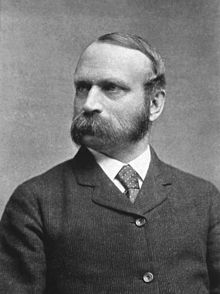Charles Frederick Chandler
Charles Frederick Chandler (born December 6, 1836 in Lancaster , Massachusetts , † August 25, 1925 in East Hartford , Connecticut ) was an American chemist and professor at Columbia University . He was also a public health pioneer in New York City. His work in this area became a model for other cities in the United States. He was also successful as a consultant to the chemical industry.
Life
Chandler, the son of a clothing store owner, grew up in New Bedford, Massachusetts and took an early interest in chemistry, geology and mineralogy (although he was inspired by public lectures by Louis Agassiz ). He studied chemistry at the Lawrence Scientific School of Harvard University and from 1854 in Göttingen under Friedrich Wöhler and Heinrich Rose (his teacher in analytical chemistry). In 1856 he received his doctorate in Göttingen . He then went to Union College in Schenectady , where he was initially a laboratory assistant (officially a kind of caretaker) to Charles A. Joy , became an associate professor in 1857 and a professor of chemistry in 1859. From 1864 he was a professor at the newly founded Columbia School of Mines in New York (from 1897 part of Columbia University), where he became dean, which he remained until 1897. He taught at Columbia University until 1910. In addition, he lectured on chemistry and forensic medicine at Columbia College of Physicians and Surgeons, Columbia College, and the College of Pharmacy in New York (Chemistry professors were initially poorly paid in the US and often had to teach in multiple locations or have multiple jobs ).
Chandler held one of the earliest professorships in analytical chemistry and had a great influence on the establishment of chemistry as a profession in the USA. Publicly he also worked in the improvement of hygiene, water supply and disposal as well as food and drug control (especially milk) with his work for the Metropolitan Board of Health in New York, whose chemist he was from 1866 and whose president he was from 1873 to 1883. In 1873 he made sure that the milk slips that had been common up until then in New York were stopped (responsible for numerous deaths of infants), took action against toxic components in cosmetics and alcoholic beverages, urged building regulations for tenement houses (Tenement House Act), who provided adequate lighting and ventilation and set a strict quality control for the kerosene of kerosene lamps, which until then often had explosive raw gasoline components. He himself invented improvements in the sanitary installations, which he made available without patent, and ensured a supply of clean water and an improvement in the sewage system. He improved access to health care for poorer sections of the population, provided free vaccinations and built disease hospitals. He was also a frequent expert witness in legal proceedings. With the chemist William H. Nichols , he ensured quality control of the Baumé grades . As a chemist, he worked on aniline dyes, photo materials, gas for lighting, petroleum, sugar and electrochemistry.
In 1874, Chandler was elected to the National Academy of Sciences . Since 1875 he was a member of the American Philosophical Society . 1899/1900 he was President of the Society of Chemical Industry .
With his brother William, who was also a chemist, he published the journal American Chemist until 1877 . He was one of the main driving forces behind the founding of the American Chemical Society (and its journal The Journal of the American Chemical Society ) in 1876 and its president from 1881 to 1889. He had previously organized a meeting of American chemists at the grave of Joseph Priestley in Northumberland in 1874 to mark the centenary of Priestley's discovery of oxygen. He was also a co-founder in 1898 and first president of The Chemists' Club in New York until 1900.
At Columbia University he also founded a chemical museum (Chandler Chemical Museum).
In 1920 he received the Perkin Medal .
His younger brother William was also a noted chemist, professor at Lehigh University. With him he published the American Chemist from 1870 to 1877 (the forerunner of the Journal of the American Chemical Society ).
literature
- Winfried R. Pötsch (lead), Annelore Fischer, Wolfgang Müller: Lexicon of important chemists . Harri Deutsch 1989, ISBN 3-8171-1055-3 , pp. 83f.
Web links
Individual evidence
- ↑ biographical data, publications and Academic pedigree of Charles Frederick Chandler at academictree.org, accessed on 23 January 2018th
| personal data | |
|---|---|
| SURNAME | Chandler, Charles Frederick |
| BRIEF DESCRIPTION | American chemist |
| DATE OF BIRTH | December 6, 1836 |
| PLACE OF BIRTH | Lancaster , Massachusetts |
| DATE OF DEATH | August 25, 1925 |
| Place of death | East Hartford , Connecticut |

